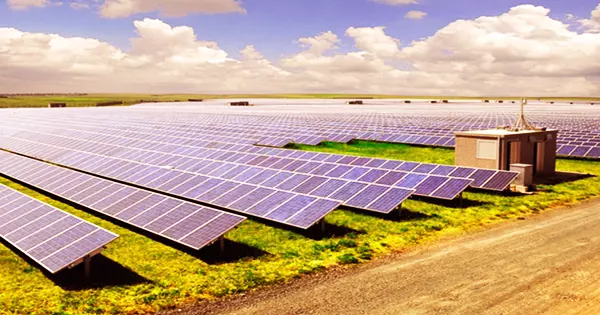Researchers at Sandia National Laboratories used massive sets of real-world solar data and powerful machine learning to investigate the effects of severe weather on solar farms in the United States and figure out what elements influence energy output. Their findings were published in the scholarly journal Applied Energy earlier this month.
A solar farm is a huge group of photovoltaic (PV) solar panels that absorb solar energy, convert it to electricity, and then transfer it to the power grid for distribution and consumption by consumers like us. Other ground-mounted solar arrays big enough to give power to numerous houses might be included in a larger definition of solar farms. The term “solar farm” can be used to describe both domestic community solar and big utility-scale solar.
Hurricanes, blizzards, hailstorms, and wildfires all pose a threat to solar farms, both directly and indirectly, by blocking sunlight and reducing power generation. Two Sandia researchers looked through repair tickets from over 800 solar farms in 24 states and compared them to power generating data and weather records to see how severe weather affected the facilities. They seek to improve the resilience of solar farms to harsh weather by understanding the elements that contribute to poor performance.

“Trying to understand how future climate conditions could impact our national energy infrastructure, is exactly what we need to be doing if we want our renewable energy sector to be resilient under a changing climate,” said Thushara Gunda, the senior researcher on the project. “We’re focusing on extreme weather events for now, but we’ll eventually expand to chronic exposure situations like constant high heat.”
Hurricanes and snow and storms, oh my!
The Sandia research team first analyzed six years of solar maintenance data for significant weather-related phrases using natural-language processing, a kind of machine learning employed by smart assistants. This study’s analytical techniques have subsequently been published and made freely available to other solar researchers and operators.
“Our first step was to look at the maintenance records to decide which weather events we should even look at,” said Gunda. “The photovoltaic community talks about hail a lot, but the data in the maintenance records tell a different story.”
Despite the fact that hailstorms are expensive, they did not appear in solar farm maintenance records, Gunda said. This is likely because operators tend to track hail damage through insurance claims. Hurricanes, on the other hand, were referenced in over 15% of weather-related maintenance records, followed by other meteorological words including snow, storm, lightning, and wind.
“Some hurricanes damage racking the structure that holds up the panels due to the high winds,” said Nicole Jackson, the lead author on the paper. “The other big concern we’ve discovered via maintenance records and conversations with industry partners is flooding, which prevents access to the site and delays the process of re-starting the plant.”
Using machine learning to find the most important factors –
They then analyzed the impact of severe weather on solar farms by combining more than two years of real-world energy production data from more than 100 solar farms in 16 states with historical meteorological data. Snowstorms had the greatest impact on power generation, followed by hurricanes and a general category of other storms, according to data.
The researchers then utilized a machine learning system to discover the elements that led to the poor performance caused by these extreme weather occurrences.
“Statistics gives you part of the picture, but machine learning was really helpful in clarifying what are those most important variables,” said Jackson, who primarily conducted the statistical analysis and the machine learning portion of the project. “Is it where the site is located? Is it how old the site is? Is it how many maintenance tickets were submitted on the day of the weather event? We ended up with a suite of variables and machine learning was used to hone in on the most important ones.”
She discovered that severe weather had the greatest impact on older solar arrays. According to Jackson, solar farms that had been in operation for more than five years had higher wear and tear as a result of being exposed to the weather for extended periods of time.
Gunda agreed, adding, “This work highlights the importance of ongoing maintenance and further research to ensure photovoltaic plants continue to operate as intended.”
Low sunlight levels at the location owing to cloud cover and the amount of snow, followed by various geographical aspects of the farm, were the second most critical variables for snowstorms, which were unexpectedly the kind of storm with the greatest influence on power generation.
After age, the amount of rainfall and the timing of the next hurricane, primarily hurricanes Florence and Michael, had the next biggest influence on productivity. Wind speeds were surprisingly low, yet they were considerable. This is probable because solar farms are preemptively shut down when high wind speeds are expected, resulting in minimal production, according to Gunda.
Expanding the approach to wildfires, the grid –
As an impartial research institution in this space, Sandia was able to collaborate with multiple industry partners to make this work feasible. “We would not have been able to do this project without those partnerships,” Gunda said.
The research team is expanding the effort to investigate the impact of wildfires on solar farms. They were unable to research wildfires since they were not recorded in maintenance logs. When a wildfire threatens a solar farm, operators don’t take the time to prepare a maintenance report, according to Gunda. “This work highlights the reality of some of the data limitations we have to grapple with when studying extreme weather events.”
“The cool thing about this work is that we were able to develop a comprehensive approach of integrating and analyzing performance data, operations data, and weather data,” Jackson said. “We’re extending the approach into wildfires to examine their performance impacts on solar energy generation in greater detail.”
The researchers are now expanding their research to look at the impacts of severe weather on the entire electrical system, as well as adding additional production data and answering even more questions to assist the grid to adapt to changing climates and emerging technology. The Solar Energy Technologies Office of the Department of Energy-funded this study, which was carried out in collaboration with the National Renewable Energy Laboratory.
















